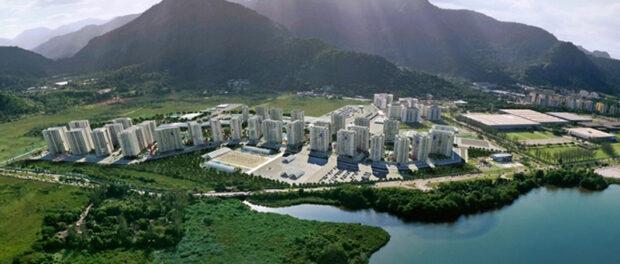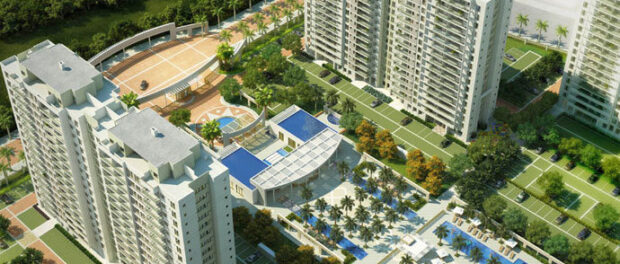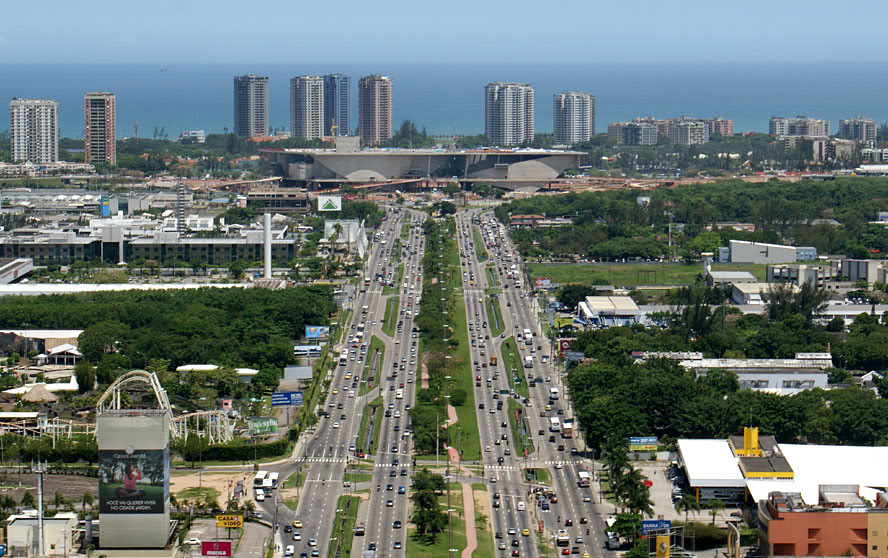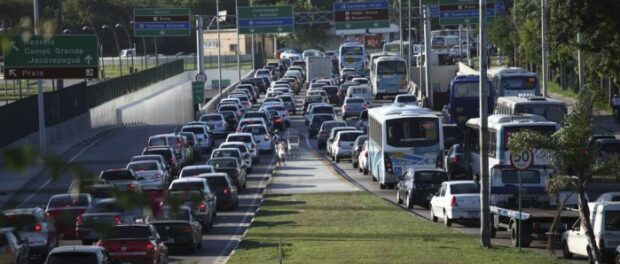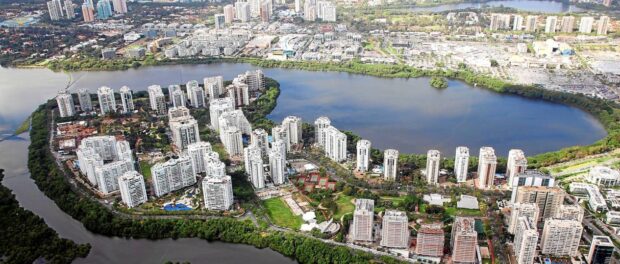
The gated community is a well-known phenomenon across the Americas. The model first gained popularity in the United States before South American countries adopted this architectural style in the 1970s. Real estate developers created and marketed secluded private spaces with an inner logic of safety and exclusiveness and they have been part of the Brazilian city ever since.
The 2014 World Cup and 2016 Olympic Games have spurred these projects further, with many expensive apartment complexes erected in recent years. The Olympic project Ilha Pura, the Athletes’ Village which will be turned into luxury apartments, has attracted scrutiny around these complexes, but there are examples of condominíos fechados (closed condominiums) all over Rio de Janeiro.
The appearance of building an elite and unequal city finds justification in the economic theory of Kuznet’s curve: during economic progress inequality will first grow before everybody profits. Proponents argue that more available luxury housing should draw people who can afford to live there to move to Rio de Janeiro and bring their spending with them, jobs in construction and services will be created, and the whole city will profit from the wealth and jobs that trickle down from their spending.
However such a simplistic view obscures the impractical, undemocratic, and socially unsustainable characteristics of privatizing neighborhoods. This real estate trend further marginalizes the poor by blocking physical and social mobility, but those who can afford it will continue to desire these communities as long as the government fails to guarantee quality public services including security.
For this article I interviewed residents of several gated communities in Barra da Tijuca about their motivations for living there and how they understand their communities. I interviewed: Ana and Pedro, a young couple living together in Via Barra; Vinicius, a 35-year-old who lives with his wife (a doctor) in Via Barra too; Felipe, a married man with a young child and who has lived in the gated community Península all his life; and Marcelo, a single man in his thirties who moved back into his parents’ house in Atlântico Sul after living abroad for awhile.* All these condominiums come with a package you might find in a luxury hotel: playgrounds, children’s daycares, spaces to work, pools, saunas, gyms, soccer or tennis courts, coffee shops and social lounges.
Understanding the demand
The Brazilian State’s monopoly of violence has been compromised by “powerful militia groups, mercenaries and death squads, vigilantes, private police and security companies [who] seek political or economic security.” The lack of a stable social contract between the people and a reliable government with credible security institutions makes for a situation of real and perceived insecurity, and leads people to long for a safe haven.
All interviewees mentioned security as one of the reasons for living in a gated community. Pedro emphasizes that: ”This form of living only exists because of all the violence.” They all described a sense of security within their parameters, giving examples from not having to worry about children playing outside to the comfort of going for a run after dark.
Still, fear alone may not be enough to erect a neighborhood with as many gated communities as Barra da Tijuca. The comforts of a sauna, gym or swimming pool a few floors down from home are also attractive features.
Felipe described a trend of people moving away from rising real estate prices in Rio’s South Zone to the relatively less expensive Barra. Moving to neighborhoods in the North Zone was an option, he explains, but ”it’s more familiar to live with people with the same habits and culture, with the same taste.” This describes another dimension of safety and comfort that is non-physical and identity-based, a human characteristic to “stick to what you know.” His comment also highlights the prevalence of perceived stark distinctions between different regions of the city and the people who live in them.
The desire for space was another important factor for most interviewees: ”The idea that everyone in Barra da Tijuca is extremely rich is a myth,” Vinicius stresses. ”There are many hardworking people that just want to live with some room and in less crowded places than [the South Zone] and Central Rio.” He thinks many residents have a love-hate relationship with the neighborhood, as it offers room to breathe but at the cost of being further away from many facilities and charms that the city has to offer.
Undemocratic space as a new center of daily life
There is a downside to this physical and social comfort which has been emphasized in academic literature on gated communities. The 2016 Olympics have paved the way for large public-private investment projects that seek to give Barra da Tijuca a more central role in the city. In his masters thesis on Barra da Tijuca and the Olympic Project, urbanist Renato Cosentino describes a process of relocation by social class due to this strong market factor that shifts wealth to this western area of the city.
Vinicius warns that blindly following this market logic has not paid off: ”People keep coming and buying, while there is no plan for them. The sewerage is not connected and traffic is always intense. There is too much growth without a sustainable template for it.”
Furthermore, the consolidation of many facilities within one’s private property—or the privatization of the public sphere—creates an undemocratic space that limits societal interaction and exacerbates social differences. Marcelo says he is part of a ”7am gym group”—a number of residents of the apartment complex who interact daily as they work out before work. He describes children taking sports classes in the pool or sportsfields, his mother taking part in bible studies on the sixth floor, after dinner sports activities, condominium parties on national holidays, and older people playing jeu de boules.
The importance of these kinds of spaces for more inter-class interactions should not be underestimated, as they allow people to connect with and humanize those they wouldn’t encounter in other contexts. A gym, church, or football team are spaces where new social connections and ties can be built. Often they are already partially segregated due to the location and participants’ connections, but in their traditional form of serving a non-gated community they still leave room for plural interaction. In gated communities, these social activities take place in a private, exclusive space, where even the police need a warrant to enter. This limitation on interaction to a select group of people in a specified income bracket legitimizes an undemocratic sphere and establishes segregation as the modus operandi for the hundreds of thousands of cariocas now living in such communities.
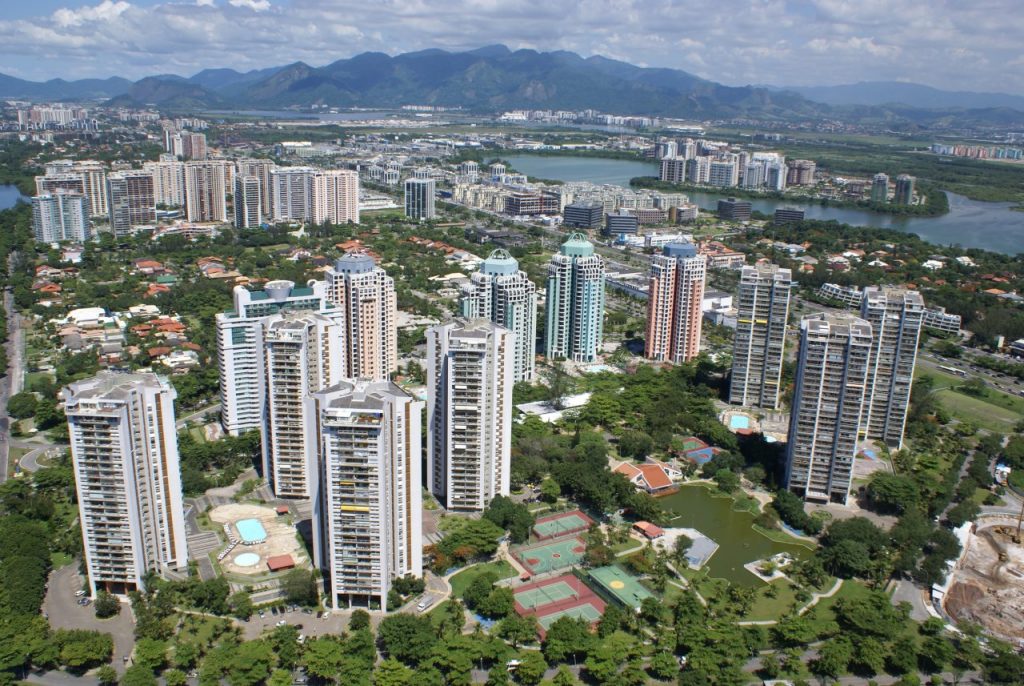
Often due to fear, residents feel forced to stay inside their community and nearly all mini social interactions of a normal neighborhood are exercised within the homogenous environment of a walled community. It is not just the physical protection: security seems part of a culture, a way of life that has emerged with the normalization of such condominiums. Vinicius explains: ”People don’t trust the world outside the walls anymore. Parents tell their children to play within, because then they don’t have to worry. But this way you teach children this fear too, while in other communities one knows the neighbors and can trust that they keep an eye out too.” This feeling forced to lock themselves in creates a serious limitation on mobility.
Within this type of community, ‘other parts of society’ remains a vague concept. Marcelo says: ”The favelas for me raise many question marks. I always hear two stories: either ‘traffickers and violence,’ or ‘good people always trying to find a smile.’ I’m curious what the nuanced story is, but on the other hand I also feel uncomfortable as a rich kid in the favela. It’s a flag I’m not very happy to carry.” This sentiment may not be limited to Rio’s gated communities, as many upper-middle-class cariocas have yet to visit a favela. Still, erecting physical barriers around not just a home but a community means residents are even less likely to cross paths with favela residents, outside of those who may be hired to work within the gates.
Gated community residents as citizens
As spaces for inter-class humanization diminish, it becomes less obvious that the problems of “the outside” are relevant. The privatization of security is combined with private solutions to other government services as well, such as health care and education, which creates a sense of non-reciprocity towards the State. When asked what made her and her husband feel like Brazilian citizens, Ana replied: ”Simply the fact that we were born here. The state does nothing for us. 25% of our income goes to taxes and 30% to private institutions that actually function, while we don’t receive any service in return.” It is this perceived lack of an effective social contract that alienates inhabitants from the government and societal issues.
”We pay twice,” Vinicius argues, ”because we pay taxes for healthcare, but still pay for our own healthcare services.” Of course, this problem is felt by citizens outside of the gated condominiums too. The lack of government legitimacy creates the sense “we have to take care of ourselves” and legitimizes the walls, security guards and cameras.
Even though academic literature on gated communities stresses issues of segregation, class consolidation and dehumanization, these interviews highlight that residents argue they are just responding to basic desires to live their lives with fewer worries. They pay their taxes and also pay to receive quality services, and live in an environment that offers more perceived security than what the government can provide.
Mobility
In a Studio-X event concerning mobility and the modern metropolis, Fluminense Federal University urban planning professor Vinícius Netto described how the gated community is distanced from the public street and discourages any transportation that is not heading straight for it as the destination. This is in stark contrast to favelas, for example, where low-rise, multi-use buildings and often narrow streets invite residents to meet in public and go by foot.
This is especially a problem in the less diverse parts of Barra da Tijuca, as there is hardly any variation in the type of housing or room for micro-economies in the form of shops and workspaces: everybody has to go by car to reach their point of destination. Combined with the prognosis that the number of cars will double in the next 15 years, this makes for a paralyzing cocktail. Furthermore, the private walled “garden” between the road and the apartment complexes blocks traffic from shorter routes. Netto warns that there are fewer apartments and more traffic per meter of street.
Vinicius emphasizes that residents tend to use the roads inefficiently too, which adds to the problem: ”People refuse to take public transport. Look around: it’s all one person per car, everywhere.”
Inefficient road use and traffic is not just a problem for residents of gated communities, but dramatically impacts commutes for lower-income cariocas who live in the extreme West Zone, beyond Barra da Tijuca, whose routes to work in the city center take them through regions dominated by apartment complexes. As so many of the more than 77,000 people removed from their homes in Rio since 2009 have been relocated in Minha Casa Minha Vida public housing in the West Zone, the physical barriers to mobility serve to further marginalize this displaced population.
The closed characteristics and invariability of Barra architecture doesn’t benefit the inhabitants either. Felipe describes Barra as “an island, where you can’t get anywhere by foot. Barra da Tijuca is far away from everything and the buses are very crowded.”
Marcelo mentioned the word “island” too: “Barra is far away from the stereotype ‘brand’ Rio, with its beaches and babes on the one hand, and dripping violence on the other. It is kind of an island, lonely and on its own. I love to see movies in the cinema and the best one is in Botafogo, but that is too far away to visit easily.”
Redesigning safety
While the gated community’s design has inherent undemocratic characteristics which are only made worse by the monotone design of Barra da Tijuca as a whole, inhabitants express a fundamental need for safety and they have the right to establish a community where their need is satisfied. A problem arises in that this isolation creates a self-fulfilling prophecy, because walls dehumanize the outside and reinforce fear to a new abstract level, which ultimately further exacerbates societal tensions and inequality leading to more violence. A vicious cycle.
As Netto argued at the Studio-X event, Rio’s municipal government should invest in more diverse neighborhood designs that facilitate interaction with the street and stimulate other transportation options than the car. Blindly following current market logic will result in inefficient infrastructure, monotone neighborhoods and relocation by class. The market will only change course when it’s too late: when people start complaining about these growing problems and Barra’s image is in decline. A feeling of safety should not just come from guards and gates, but from being familiar and comfortable with different groups and classes of citizens.
It is not too late to change direction. Vinicius observes that ”although there is a strong sense of protecting ‘my stuff’ in Brazil, everybody still talks to each other.” In his opinion, rich and poor, black and white, people are socially open. By reversing the process of becoming a tourist on the “island” in one’s own community, the city has to look more like home again, and home should look less like a vacation paradise.
Christian Kuitert is pursuing a Masters degree in ‘Conflict, Territories and Identity’ at Radboud University, Netherlands, focusing on comparative citizenship in Rio’s favelas and condominium communities.
*All names have been changed.

